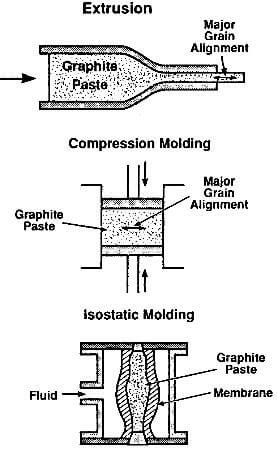
- English
- Español
- Português
- русский
- Français
- 日本語
- Deutsch
- tiếng Việt
- Italiano
- Nederlands
- ภาษาไทย
- Polski
- 한국어
- Svenska
- magyar
- Malay
- বাংলা ভাষার
- Dansk
- Suomi
- हिन्दी
- Pilipino
- Türkçe
- Gaeilge
- العربية
- Indonesia
- Norsk
- تمل
- český
- ελληνικά
- український
- Javanese
- فارسی
- தமிழ்
- తెలుగు
- नेपाली
- Burmese
- български
- ລາວ
- Latine
- Қазақша
- Euskal
- Azərbaycan
- Slovenský jazyk
- Македонски
- Lietuvos
- Eesti Keel
- Română
- Slovenski
- मराठी
- Srpski језик
What is the process of isostatic graphite manufacturing?
The process of isostatic graphite manufacturing is Selecting raw materials, Blending, Molding, Isostatic pressing, Carbonization, Graphitization.
Isostatic pressure molding technology involves placing the specimen in a closed package and pressing it within a high-pressure cylinder. The technique utilizes the incompressible nature of the liquid medium to transfer pressure uniformly from all sides of the specimen, resulting in an even distribution of pressure. When the fluid medium is injected into the pressure cylinder, the pressure is uniformly transferred to all directions due to the principle of fluid dynamics. As a result, the specimen in the high-pressure cylinder is subjected to uniform pressure from all directions.

According to the temperature during molding and consolidation, they are classified as Cold Isostatic Pressing (CIP), Warm Isostatic Pressing (WIP), and Hot Isostatic Pressing (HIP). These three different types of isostatic pressing techniques use different equipment and overmold materials due to the different press temperatures and pressure media implemented.
Isostatic pressure molding is a technique that can produce a wide range of isotropic and anisotropic products. The resulting products have a uniform structure, high density, and strength. This technique is typically used for manufacturing special graphite and specifically for producing large-sized special graphite products.
Currently, the primary molding process for carbon/graphite materials is cold isostatic pressing, followed by hot isostatic pressing. The latter process combines roasting and densification processes to achieve the desired properties in the final product.




